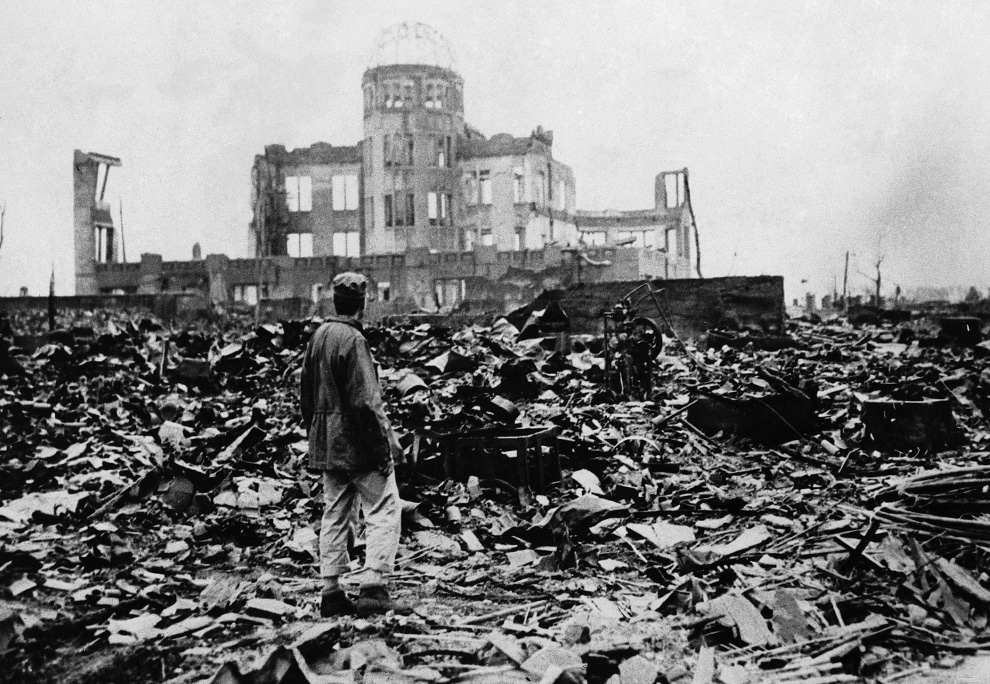
Views: 340
With rare exception, the question of whether the atomic bombs were necessary to end World War Two is debated only deep within the safety of academic circles.
Could a land invasion have been otherwise avoided? Would more diplomacy have achieved the same ends without the destruction of two cities? Could an atomic test on a deserted island have convinced the Japanese? Was the surrender instead driven primarily by the entry of the Soviets into the Pacific War, which, by historical accident, took place two days after Hiroshima—and the day before Nagasaki was immolated?
But it is not only the history of the decision itself that is side stepped. Beyond the acts of destruction lies the myth of the atomic bombings, the post-war creation of a mass memory of things that did not ha ppen.
ppen.
The short version of the atomic myth, the one kneaded into public consciousness, is that the bombs were not dropped out of revenge or malice, immoral acts, but of grudging military necessity. As a result of this, the attacks have not provoked or generated deep introspection and national reflection.
The use of the term “myth” is appropriate. Harry Truman, in his 1945 announcement of the bomb, focused on vengeance, and on the new, extraordinary power the United States alone possessed. The military necessity argument was largely created later, in a 1947 article defending the use of the atomic bomb, written by former Secretary of War Henry Stimson, though actually drafted by McGeorge Bundy (later an architect of the Vietnam War) and James Conant (a scientist who helped build the original bomb). Conant described the article’s purpose at the beginning of the Cold War as
“You have to get the past straight before you do much to prepare people for the future.”
The Stimson article was a response to journalist John Hersey’s account of the human suffering in Hiroshima, first published in 1946 in the New Yorker and later as a book. Due to wartime censorship, Americans knew little of the ground truth of atomic war, and Hersey’s piece was shocking enough to the public that it required that formal White House response. Americans’ general sense of themselves as a decent people needed to be reconciled with what was done in their name. The Stimson article was quite literally the moment of creation of the Hiroshima myth.
The national belief that no moral wrong was committed with the atomic bombs, and thus there was no need for reflection and introspection, echoes forward through today (the blithe way Nagasaki is treated as a historical after thought – “and Nagasaki, too” – only drives home the point.) It was 9/11, the new Pearl Harbor, that started a series of immoral acts allegedly servicing, albeit destructively and imperfectly, the moral imperative of saving lives by killing. America’s decisions on war, torture, rendition and indefinite detention are seen by most as the distasteful but necessary actions of fundamentally good people against fundamentally evil ones. Hiroshima set in motion a sweeping, national generalization that if we do it, it is right.
And with that, the steps away from the violence of Hiroshima and the shock-and-awe horrors inside the Iraqi prison of Abu Ghraib are merely a matter of degree. The myth allows the world’s most powerful nation to go to war as a victim after the tragic beheadings of only a small number of civilians. Meanwhile, the drone deaths of children at a wedding party are seen as unfortunate but only collateral damage in service to the goal of defeating global terrorism itself. It is a grim calculus that parses acts of violence to conclude some are morally justified simply based on who held the knife.
We may, in fact, think we are practically doing the people of Afghanistan a favor by killing some of them, as we believe we did for tens of thousands of Japanese that might have been lost in a land invasion of their home islands to otherwise end World War Two. There is little debate in the “war on terror” because debate is largely unnecessary; the myth of Hiroshima says an illusion of expediency wipes away any concerns over morality. And with that neatly tucked away in our conscience, all that is left is pondering where to strike next.
Japan, too, is guilty of failing to look deep into itself over its own wartime atrocities. Yet compared to the stunning array of atrocities during and since World War Two, the world’s only use of nuclear weapons still holds a significant place in infamy. To try and force the Japanese government to surrender (and no one in 1945 knew if the plan would work) by making it watch mass casualties of innocents, and then to hold the nation hostage to future attacks with the promise of more bombs to come, speaks to a cruelty previously unseen.
For President Obama to visit Hiroshima without reflecting on the why of that unfortunate loss of lives, acting as if they occurred via some natural disaster, is tragically consistent with the fact that for 71 years no American president felt it particularly important to visit the victimized city. America’s lack of introspection over one of the 20th century’s most significant events continues, with 21st century consequences.
Originally published on 2017-06-16
Author: Peter Van Buren
Source: Hooper’s War
Origins of images: Facebook, Twitter, Wikimedia, Wikipedia, Flickr, Google, Imageinjection & Pinterest.
Read our Disclaimer/Legal Statement!
Donate to Support Us
We would like to ask you to consider a small donation to help our team keep working. We accept no advertising and rely only on you, our readers, to keep us digging the truth on history, global politics and international relations.
FOLLOW US ON OUR SOCIAL PLATFORMS









